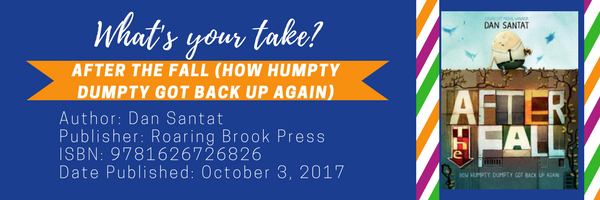For the last My Take/Your Take of this month (and this year!) Prisca and Ray share their take on After the Fall (How Humpty Dumpty Got Back Up Again) by Dan Santat, which puts a clever twist on the end of a familiar nursery rhyme.

Prisca: After the Fall is clever! As many times as I repeated the Humpty Dumpty rhyme as a child, I never wondered what might happen if his story continued. I never considered the ‘life lessons’ that could come from his story as Santat has. After his fall, Humpty Dumpty is afraid of heights. He buys cereal from the lower shelves in the store and sleeps on the floor rather than his top bunk. He is too afraid to climb the wall again, even though he loves birds and from the top of the wall he can see and be near them. I see myself in this book–feeling afraid after something goes wrong in my life. What do you think?
Ray: Something that comes to mind is, “If you fall off a horse, get right back on and try again.” Face your fears and don’t run from them. Humpty, through Santat’s story, does just that. I always tell my students to never ignore any part of a picturebook. The front dust jacket, inside the dust jacket, the hard cover, end papers and every page thereafter are critical to the total design of the book. Humpty is falling on the case (hardcover). The endpapers are illustrated but dissimilar, which is one of the four types of endpapers Larry Sipe explains. Humpty sits on the wall in the front endpapers; when you look at the back endpapers, what do you see?
Prisca: In After the Fall, Humpty transforms into a bird and flies to meet up with a group of birds. Santat uses every part of the book to tell the story. On the back side of the case the bird flies away. The internal art is incredible, too. I love the double-page spread with the close-up of Humpty’s face when the accident happens and his paper bird lands on the wall. I identify with that when I realize something has gone awry in my life. The next spread gives me a queasy feeling. Humpty looks in from the left edge as his bird lands on the wall on the right page. I don’t think there is one horizontal or vertical line on the spread. All lines are diagonal. It really shows how lines influence emotions and feelings.
Ray: One of the basic design principles that artists know in dealing with line is that there are three basic types of line: horizontal (shows calm or at rest), vertical (stability, strength) and diagonal (movement). You can see this use of diagonals indicating movement on the double page spread of the two wings, feathers flying and parts of what is left of Humpty’s shell. The final double page spread also illustrates this. I love those last two pages where Humpty faces his fears, leaves one life behind in broken pieces and takes on a new life as a bird to soar and be “as free as a bird” in his new life.
I also love Santat’s use of different layouts on each page to highlight the story. It goes from a close-up of Humpty’s head with a look of surprise or shock to a view from the ground looking up at the wall. It then moves to a single-page spread looking down from on top of the wall to the ground. Humpty is about to face his fear and climb back up the wall, which is shown on the following single-page spread with a ground level view looking straight ahead. On the following double-page spread, the reader becomes the wall and experiences fear and trembling in the close-up of the hands. I love the look on his face as he begins to crack and come apart and his new life begins. Santa does an excellent job of illustrating this story. I think readers of all ages will enjoy this book.
Title: After the Fall (How Humpty Dumpty Got Back Up Again)
Authors: Dan Santat
Publisher: Roaring Brook Press
ISBN: 9781626726826
Date Published: October 3 2017
This is the fourth and final installment of December 2017’s My Take/Your Take. To follow these continuing conversations, check back every Wednesday.
- Themes: After the Fall, Dan Santat, Humpty Dumpty, Prisca Martens, Ray Martens
- Descriptors: Books & Resources, My Take/Your Take
